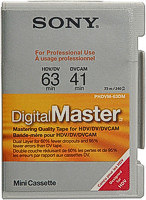The HDV Video Format

HDV is a early high-definition format developed as a compromise for the consumer and lower-end professional markets. There are two versions: HDV 720p and HDV 1080i.
HDV 720p has a resolution of 1280x720 square pixels, making a tidy aspect ratio of 16x9.
HDV 1080i records at 1440x1080 pixels, using rectangular pixels similar to widescreen DV (the HDV pixel aspect ratio is 1.33:1). This stretches the picture frame to 16x9.
HDV uses MPEG-2 compression for greater storage and bandwidth efficiency, which means that it can be used with existing MiniDV tapes. However MPEG-2 differs from traditional DV in that it uses temporal compression, i.e. compression occurs across multiple frames instead of only occurring within a single frame. This means that a single dropped frame during recording becomes much more serious, as a whole bunch of frames (known as a "group of pictures" or GOP) are affected. Instead of being a minor glitch, it's a shot-killer. For this reason it is recommended to use the more expensive tapes specifically made for the more demanding HDV format.
It's also worth noting that MPEG-2 isn't as nice to edit with as DV. As well as compromising the image quality, it places more of a burden on the editing computer. Since HDV involves both a high pixel count and temporal compression, you'll need a fairly powerful computer to edit complex projects.
HDV 1080i uses a recording data rate of 25 Mbit/s (3.125 MB/s). HDV 720p records at 19.7 Mbit/s (2.46 MB/s). Other HD formats record at 50-100 Mbit/s or higher.